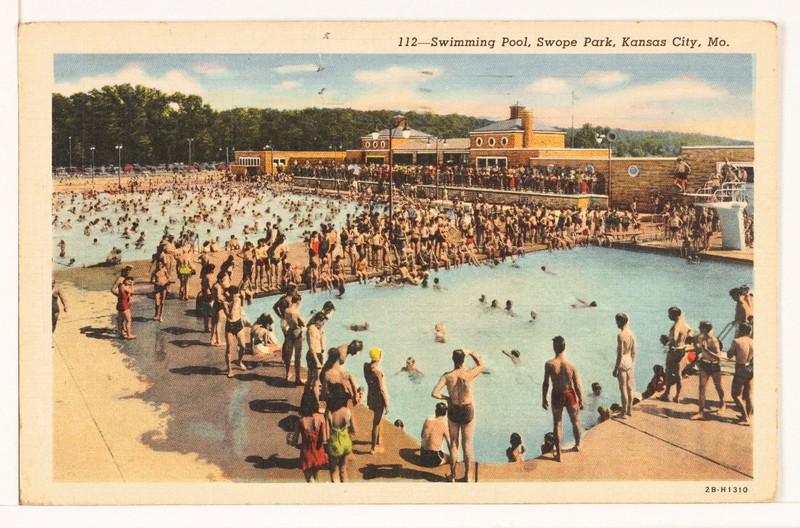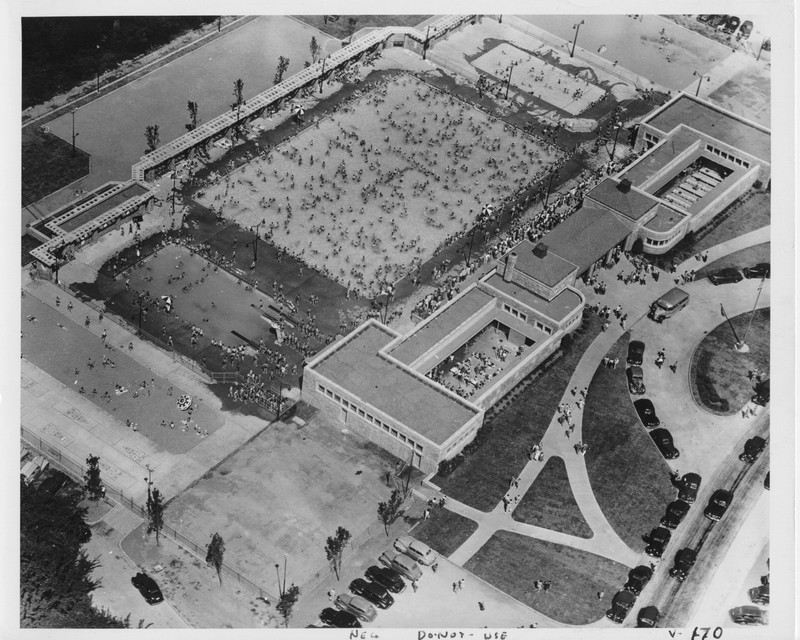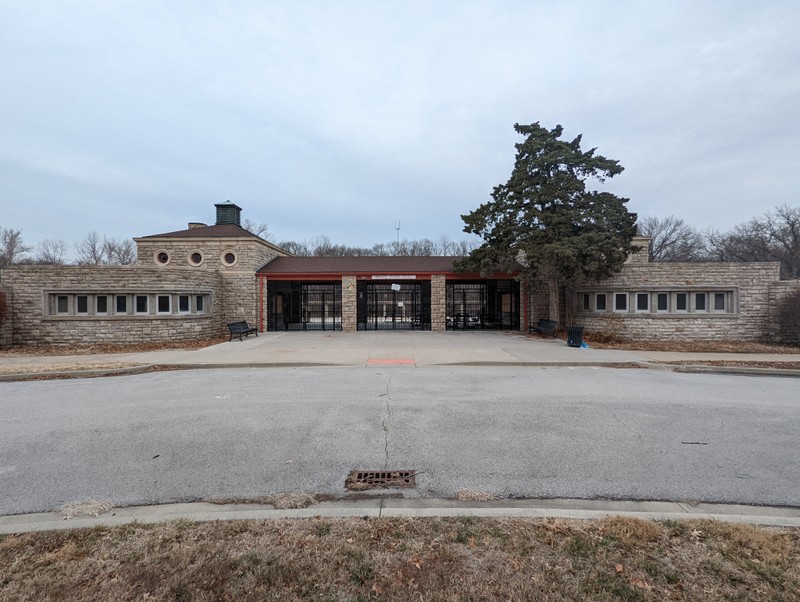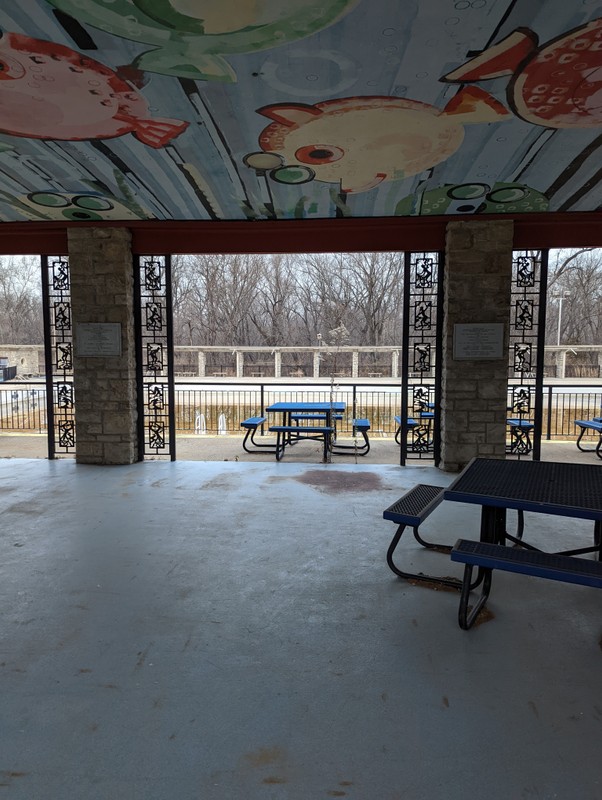Swope Park Pool
Introduction
Text-to-speech Audio
Throughout its eighty years of operation, the Swope Park Pool has been a long-term staple of the area. Situated just to the north of the lagoon, the pool was built in 1941. Surrounded by a stone wall with a southward-facing gate and locker room building, the facility consists of a 105 by 60-foot swimming pool with a deeper diving pool to the west and a splash/wading area to the east for younger children. Though the basic structure has not changed over the course of the pool's lifetime, it played host to an important element of the growth of racial equality in the Kansas City area. The pool was closed from August 2, 1951 to June 12, 1954 as part of a legal battle to desegregate the pool. Once this goal was achieved, Swope Park Pool continued to serve the surrounding neighborhoods for the next sixty-seven years. Unfortunately, the pool did not open at the start of the 2022 season, with the city citing concerns over the advanced age of the facility. Though plans have been floated to repair and update the pool, as of now, the future of this Swope Park fixture remains uncertain.
Images
Postcard of Swope Park Pool, date unknown

Aerial image of Swope Park Pool, dated 1945

Picture of Swope Park Pool front gate, taken December 7th, 2022

View through front gate of Swope Park Pool, taken December 7th, 2022

Backstory and Context
Text-to-speech Audio
The pool was built in 1941 as a collaboration between the city of Kansas City and the Works Progress Administration, utilizing $400,000 from the WPA and $125,000 of city money raised from pool admission fees. Consisting of a 105 by 60-foot swimming pool with a deeper diving pool to the west and a splash/wading area for younger children to the east, the pool was designed to serve up to 3,000 guests. The swimming area is surrounded by a limestone brick wall with a southward-facing gate and locker room building, with dressing rooms and showers on either side of the entrance.
Built during an era of segregation, Swope Park Pool only served the white population of Kansas City until 1951. According to a 2021 article from the Kansas City Star, the first seeds of the conflict surrounding the pool were planted in May of 1951, when Kansas City voted to desegregate events held at Municipal Auditorium, the Municipal Air Terminal, and Starlight Theatre. The article goes on to state that the city council did not include the Swope Park Pool in these considerations because they considered the Parade Park Pool (now the Gregg/Klice Community Center) at 17th and The Paseo to provide a service equal to Swope Park, despite only having a single pool with a capacity of 250. On June 20, 1951, six African-American Kansas Citians were forbidden from purchasing admission to Swope Park Pool. On August 2nd, the Kansas City branch of the NAACP filed a lawsuit on behalf of Esther Williams, Lena Rivers, and Joseph Moore, stating that the discrepancy between the Swope Park and Parade Park facilities violated the 14th Amendment, as well as making the point that the tax dollars of Black citizens had been hypocritically spent on a pool that those citizens could not use. The NAACP's lawyers, including future Supreme Court Justice Thurgood Marshall, received a favorable ruling from District Court Judge Albert A. Ridge, who determined that the inequality of the two pool facilities meant that the city would have to either construct an equivalent pool for Black patrons in Swope Park or desegregate the existing one.
However, the opposition appealed the decision, as well as filing a motion to keep the pool segregated until any appeals were complete. According to the Star, when Judge Ridge denied the motion, "the park board voted unanimously in May 1952 to keep the pool closed until a final decision was made on the city’s appeal." The 8th U.S. Circuit Court of Appeals in St. Louis reached the same conclusion as Judge Ridge, pushing the Parks Board to close the pool for the 1953 season as well. However, when the U.S. Supreme Court refused to hear the case that October, the Parks Board voted to open the newly-integrated facility the next year. According to KC History, the 1954 opening was surrounded by some concern, as the 1949 desegregation of public pools in St. Louis had given rise to riots in which several people were injured when whites gathered to harass Black patrons. In anticipation of similar violence, KC History states that Kansas City produced several public education campaigns explaining the change and stationed riot police on the site. However, July 12, 1954 saw no conflict at the now-desegregated pool. Though this event marked an important step towards equality in Kansas City, it is worth noting that the ruling on the Swope Park Pool still existed within the bounds of the 1896 Plessy v. Ferguson ruling. The desegregation of Swope Park Pool was partially a result of a lack of funds for a "separate but equal" facility in Swope Park. The landmark decision of Brown v. Board of Education would not be decided until May of 1954, seven months after the Supreme Court declined to hear the Swope Park case.
After its integration, the Swope Park Pool continued to serve the population of Kansas City, Missouri. The pool has been renovated several times over the decades, including the installation of a modernized "sprayground" children's area in place of the original wading pool and a resurfacing before the 2018 season. Unfortunately, the pool was not opened for the 2022 season, with K.C. Parks citing age and temperature fluctuations as the root cause of advanced concrete deterioration, rendering the pool unsafe for use. As of the writing of this article in 2023, Swope Park pool is not listed on the K.C. Parks website, leaving the ultimate fate of this historic Kansas City recreation facility unknown.
Sources
Coombs, Cathy. “Historical Swope Park Swimming Pool in Kansas City, Missouri Desegregates in 1954.” Medium. Medium, May 31, 2022. https://medium.com/@cjcwriter04/historical-swope-park-swimming-pool-in-kansas-city-missouri-desegregates-in-1954-a520bd5f187a.
Roe, Jason. “This Week in KC History: Water Rights.” KC History. Accessed December 2, 2022. https://kchistory.org/week-kansas-city-history/water-rights.
“Swope Park Pool.” African American Heritage Trail of Kansas City. Accessed December 1, 2022. https://aahtkc.org/swopeparkpool.
“Swope Park Pool.” K.C. Parks. Retrieved by WayBack Machine, February 17, 2022. https://web.archive.org/web/20220217184413/https://kcparks.org/places/swope-park-pool/.
Torres, Aaron. “Kansas City Closed This Public Pool for Two Years Instead of Letting Black People In.” The Kansas City Star, October 1, 2021. https://www.kansascity.com/news/your-kcq/article253962623.html.
From the Mrs. Sam Ray Postcard Collection (SC58), Missouri Valley Special Collections, Kansas City Public Library, Kansas City, Missouri https://kchistory.org/islandora/object/kchistory%253A109082
General Collection, Missouri Valley Special Collections, Kansas City Public Library, Kansas City, Missouri https://kchistory.org/islandora/object/kchistory%253A104753
Taken by Peter Sears, Black Archives of Mid-America Archives and Digitization VISTA
Taken by Peter Sears, Black Archives of Mid-America Archives and Digitization VISTA
